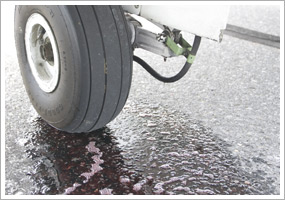Custom content for the Sept. 30, 2011, issue of 'AOPA ePilot' newsletter
| The following stories from the Sept. 30, 2011, edition of AOPA ePilot were provided to AOPA members who expressed an interest in the particular subject areas. Any AOPA member can receive information tailored to their areas of interest by updating their preferences online |
training tips‘Braking Bad’ What happened? When this airplane touched down, the pilot’s feet (or sometimes, an unwitting passenger’s) were a little too far up on the rudder pedals, engaging the brakes. Had the winds been a little gusty, or more of a crosswind, things might have turned out much worse. Time to taxi clear and inspect for any damage. All pilots remember their early training days, when taxiing was a challenge requiring a mysterious combination of power, brakes, nosewheel or tailwheel steering, and rudder. Some student pilots take longer than others to achieve grace in this area—and landings may reveal flaws in the technique after performance of the other ground tasks is consistently satisfactory. Trainers take a pounding out there, so give yours (and any rental aircraft) a thorough going-over before flights to spot signs of bad braking. You are looking for flat spots on tires, leaking brake fluid (what color is it?), and the condition of brake pads. Beware of worn spots on a nosewheel tire caused by excessive braking while the nosewheel was turned. That can cause startling, severe nosewheel shimmying on takeoff. What’s the cure? “Ease back on the control column and the noise and vibrations stop. And be ready, because the shimmy may return when you land,” explained the November 2008 Flight Training feature “What’s wrong with this airplane?” Aside from aggressive techniques such as short-field landings, braking tends to be a second choice for aircraft control when other methods are available. On taxi, using minimum power necessary to roll at a walking gait, along with nosewheel steering, minimizes need for brakes. After touchdown, aerodynamic braking is the preferred deceleration method—so keep the elevator control full back! Under wet, icy, or other slippery conditions, many airports issue braking action reports to help alert pilots to possible control hazards. And to answer a question posed above, brake fluid is red. training productsDynon transceiverDynon Avionics, maker of feature-packed systems for Experimental and light sport aircraft, also manufactures a handheld transceiver. The DX15 has 100 memory channels, quick recall of the last 10 frequencies used, a rechargeable battery, and a standard three-year warranty. It weighs 8 ounces and measures 4 inches by 2.25 inches. The unit is available through Dynon dealers such as Wicks Aircraft Supplies, which is selling it for $160.
Note: Products listed have not been evaluated by ePilot editors unless otherwise noted. AOPA assumes no responsibility for products or services listed or for claims or actions by manufacturers or vendors. final exam
Question: I received my private pilot certificate recently after training in a Cessna 152. Our flight school has Cessna 172s and I would like to fly one of those because it has more room and is faster than the Cessna 152. My instructor says I need an endorsement in order to fly the Cessna 172. I don’t see any requirement in the federal aviation regulations concerning this. Is he correct?
Answer: First, congratulations on passing the practical exam for your private pilot certificate. That is a major accomplishment. Now, regarding your question: From a regulatory or FAA perspective, there is no further training required in order for you to fly the Cessna 172 legally. Your airplane single-engine land rating qualifies you. However, insurance companies often require a checkout in a specific make and model of aircraft before they will allow a pilot to rent it. This might be true even if you have lots of previous time in a particular type of airplane. Your instructor was most likely referring to this insurance requirement when he said you needed an endorsement. For more on additional ratings and endorsements, see AOPA’s subject report.
Got a question for our technical services staff? E-mail [email protected] or call the Pilot Information Center, 800/872-2672. Don’t forget the online archive of “Final Exam” questions and answers, searchable by keyword or topic. |
 The trainer touches down perfectly, but instead of the expected chirp-squeak from the tires comes an astonishing wail, followed by a puff of smoke. Ouch. Clearly, this wasn’t what the pilot had in mind.
The trainer touches down perfectly, but instead of the expected chirp-squeak from the tires comes an astonishing wail, followed by a puff of smoke. Ouch. Clearly, this wasn’t what the pilot had in mind.

